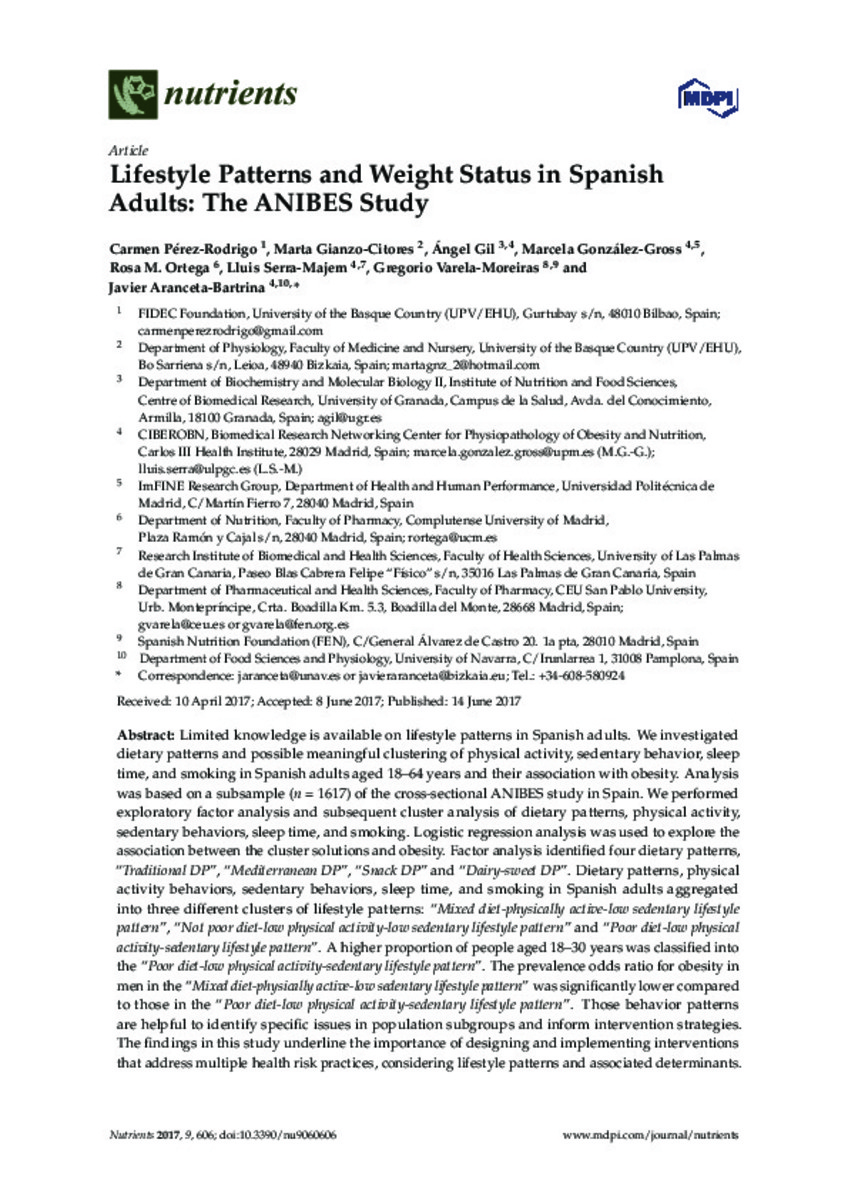Full metadata record
| DC Field | Value | Language |
|---|---|---|
| dc.creator | Perez-Rodrigo, C. (Carmen) | - |
| dc.creator | Gianzo-Citores, M. (Marta) | - |
| dc.creator | Gil, A. (Ángel) | - |
| dc.creator | González-Gross, M. (Marcela) | - |
| dc.creator | Ortega, R.M. (Rosa María) | - |
| dc.creator | Serra-Majem, L. (Luis) | - |
| dc.creator | Varela-Moreiras, G. (Gregorio) | - |
| dc.creator | Aranceta-Bartrina, J. (Javier) | - |
| dc.date.accessioned | 2017-11-30T16:40:46Z | - |
| dc.date.available | 2017-11-30T16:40:46Z | - |
| dc.date.issued | 2017 | - |
| dc.identifier.citation | Perez-Rodrigo, C. (Carmen); Gianzo-Citores, M. (Marta); Gil, A. (Ángel); et al. "Lifestyle Patterns and Weight Status in Spanish Adults: The ANIBES Study". Nutriens. 9, 2017, 1 - 17 | es_ES |
| dc.identifier.uri | https://hdl.handle.net/10171/44949 | - |
| dc.description.abstract | Limited knowledge is available on lifestyle patterns in Spanish adults. We investigated dietary patterns and possible meaningful clustering of physical activity, sedentary behavior, sleep time, and smoking in Spanish adults aged 18–64 years and their association with obesity. Analysis was based on a subsample (n = 1617) of the cross-sectional ANIBES study in Spain. We performed exploratory factor analysis and subsequent cluster analysis of dietary patterns, physical activity, sedentary behaviors, sleep time, and smoking. Logistic regression analysis was used to explore the association between the cluster solutions and obesity. Factor analysis identified four dietary patterns, “Traditional DP”, “Mediterranean DP”, “Snack DP” and “Dairy-sweet DP”. Dietary patterns, physical activity behaviors, sedentary behaviors, sleep time, and smoking in Spanish adults aggregated into three different clusters of lifestyle patterns: “Mixed diet-physically active-low sedentary lifestyle pattern”, “Not poor diet-low physical activity-low sedentary lifestyle pattern” and “Poor diet-low physical activity-sedentary lifestyle pattern”. A higher proportion of people aged 18–30 years was classified into the “Poor diet-low physical activity-sedentary lifestyle pattern”. The prevalence odds ratio for obesity in men in the “Mixed diet-physically active-low sedentary lifestyle pattern” was significantly lower compared to those in the “Poor diet-low physical activity-sedentary lifestyle pattern”. Those behavior patterns are helpful to identify specific issues in population subgroups and inform intervention strategies. The findings in this study underline the importance of designing and implementing interventions that address multiple health risk practices, considering lifestyle patterns and associated determinants. | es_ES |
| dc.language.iso | eng | es_ES |
| dc.rights | info:eu-repo/semantics/openAccess | es_ES |
| dc.subject | Cluster analysis | es_ES |
| dc.subject | Dietary patterns | es_ES |
| dc.subject | Lifestyle patterns | es_ES |
| dc.subject | Physical activity; | es_ES |
| dc.subject | Sedentary behavior | es_ES |
| dc.subject | Obesity | es_ES |
| dc.subject | Adults | es_ES |
| dc.title | Lifestyle Patterns and Weight Status in Spanish Adults: The ANIBES Study | es_ES |
| dc.type | info:eu-repo/semantics/article | es_ES |
| dc.identifier.doi | https://doi.org/10.3390/nu9060606 | es_ES |
| dadun.citation.endingPage | 17 | es_ES |
| dadun.citation.publicationName | Nutriens | es_ES |
| dadun.citation.startingPage | 1 | es_ES |
| dadun.citation.volume | 9 | es_ES |
Files in This Item:
Statistics and impact
Items in Dadun are protected by copyright, with all rights reserved, unless otherwise indicated.






